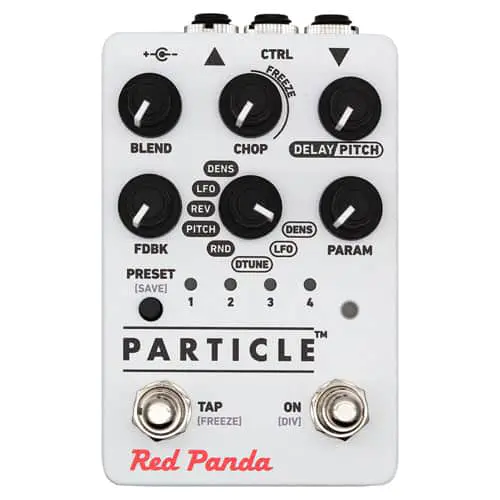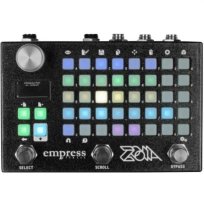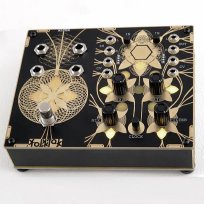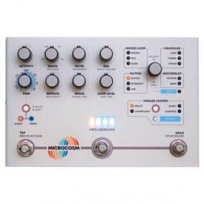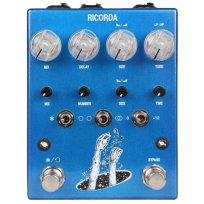An increasing number of creative musicians (including many synth and keyboard players) are adopting guitar pedals to expand their sonic palette with unusual effects. Stompboxes using an emerging type of synthesis called “granular” can be particularly inspiring for musicians interested in inserting elements of control randomness into their compositions.
Granular effects can be considered a modern evolution of the older Glitch and Stutter pedals. They perform a similar function but in an automated rather than manual fashion.
This article guides you through the best pedals on the market using granular synthesis, with a focus on pedals that work well with synthesizers and other line out instruments.
What is Granular Synthesis?
If subtractive synthesis is by far the most common type of synthesis found in musical devices, and additive synthesis is a distant second, granular synthesis could be described as one of the new kids on the block, cool and atypical.
While the former two are based on tonal and harmonic changes immediately applicable to any sound source (filters in subtractive and pitch shifting in additive), granular synthesis is, at its core, about reordering a recorded sample. That is the reason why all the pedals in this article are either delays or loopers, both effects that record and playback a portion of audio.
If you want to get technical, granular synthesis deals with the microsound time scale, splitting the sample into small slices (called grains) and reorganizing them in a different order and, potentially, with different speeds, volume, pitch, etc.
The beauty of granular is that, out of all the types of syntheses out there, is perhaps the one that most easily generates happy accidents, because it’s the least intuitive and controllable. This allows musicians to just “play around” with it without necessarily knowing where it’s taking them.
But let’s take a look at the 6 best granular pedals on the market for synths.
The Best Granular Pedals on the Market
#1 | Red Panda Particle Delay
Released in 2011, the first version of the Red Panda Particle was the first granular pedal ever made. Its circuit chops your signal into small grains and then does various strange things to its delayed signal, using the techniques of granular synthesis, but also pitch shifting and modulation algorithms. Results range from radical pitch and delay modulation to shimmering repeats to stutter/glitch sounds, depending on mode and settings. V2 (pictured above) takes things one step further by increasing the sample specs while adding a few extra modes, stereo In/Out, presets, momentary freeze footswitch, and Tap Tempo.
Check out Liam’s video about the Particle or click on the links below to explore the pedal’s 8 modes (ATTENTION: only the ones with an *asterisk* use granular synthesis):
Delay + Density | Delay + LFO | *Delay + Reverse* | *Delay + Pitch* | *Delay + Random* | Pitch + Detune | Pitch + LFO | Pitch + Density
—
#2 Chase Bliss Mood
Presented as a “study in interaction,” this playful granular delay features a Wet Channel of spatial effects (designed by Old Blood Noise Endeavours) and a Loop Channel (built with Drolo FX) that merge and interface with each other in three different routing modes, opening up a world of sonic experimentation including time-stretching, freeze, overdub, dissolve and smear. The Clock knob in the middle links the two channels setting the overall sample rate, grainy longer loops at lower settings, and pristine shorter loops at higher ones.
MkII updates the circuit to full stereo, improves the audio quality, and doubles the loop time while also adding extra momentary functions and new algorithms for overdubbing, freezing, syncing, fading, filtering, balancing, blending, and smoothing.
For the MKI nostalgics, Classic mode lets you use it exactly like the original.
Watch Liam’s video segment about the MOOD or click on the links below to hear some of its granular capabilities:
Micro-Looping | Macro-Looping | Stretch Mode | Envelope Mode | Fade | Refresh
—
#3 Walrus Audio Fable
This multi-mode pedal will resonate with guitarists interested in ambient soundscapes and textures, although, unlike the previous two, it’s mono. It offers 5 very creative modes that pair granular delay with other effects: Reverse Delay into Reverse Granular, Forward Delay into Octave Up Granular, Analog Delay into Octave Down Granular, Multi-Tap Granular into Multi-Tap Granular, and Forward Delay into Randomized Pitch Granular.
Each mode can be synched via a Tap Tempo footswitch and tweaked via 5 knobs controlling modulation, mix, time, tone, plust the X control setting the grain size, which is the length of the samples that get moved around in the delay trails. The feedback and regen knobs control the volume of the signal of the two effects present in each mode.
Watch Liam’s video segment about the Fable or click on the links below to browse its five modes:
Program 1 | Program 2 | Program 3 | Program 4 | Program 5
—
Honorable Mentions
Here’s a shortlist of other very interesting pedals using granular technology that will also work well with synthesizers:
—
Check out our comprehensive guide to granular pedals and their precursors (glitch and stutter pedals)















